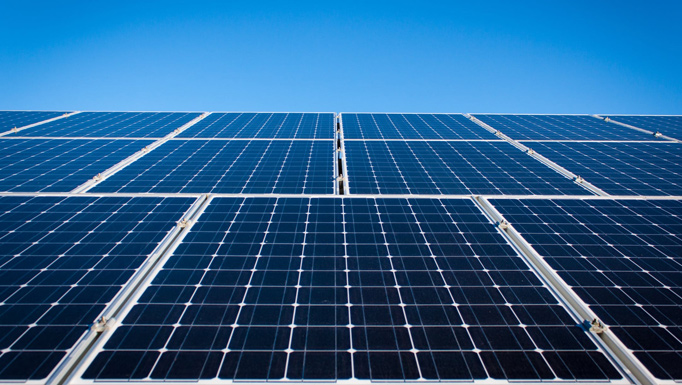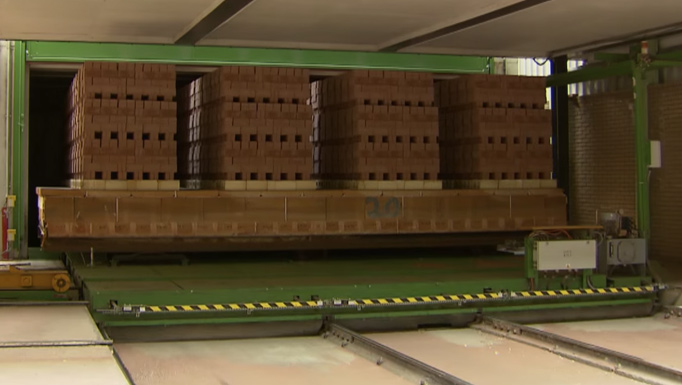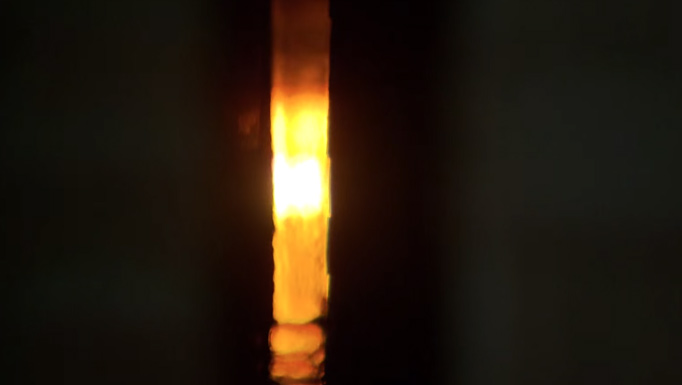Innovation, quality and sustainability are paramount. With automation, 8 people can manage the entire process. This high degree of efficiency translates into excellent value for money.
1: Raw material
Raw material for bricks
Without good clay, the bricks will be of inferior quality. Consequently, De Rijswaard only uses clay pits where the finest and purest clay can be extracted. The Westerwald in Koblenz is such an area, but also, the floodplains of the major Dutch rivers. De Rijswaard makes a point of sourcing its clay from various extraction areas, in order to produce a homogeneous raw material. This is one of the reasons we can guarantee continuity in colour and shape. De Rijswaard processes three types of clay: bronze brown (calcareous) clay for the production of yellow bricks, red-brown (ferrous) clay for red-coloured bricks and natural clay for natural coloured bricks.
Clay Mound
The excavated clay is shipped by water and transhipped via De Rijswaard's own port and transported to the clay mound. Layer by layer the mound is raised. The ‘sum’ of the different clay layers determines the final composition of the clay. This recipe is closely monitored by means of internal and external exploratory drilling. If the clay mound meets the predetermined quality level, the clay is excavated diagonally (i.e. from all layers) and introduced to the production process.
2: Pre-processing
Pre-processing the clay
The clay arrives via a storage bin and is poured into the mixer . Manganese or lime is added (for colour), and also water. This is to prevent generating dust during the mixing process. In fact, there is very little dust anywhere in the factory: thanks to good housekeeping and modern extraction systems, all spaces are kept as dust-free as possible. After the mixer, the clay mixture continues on its way into the pug mill. This is a large mill on a grinding bed of holes for grinding stones, etc. The clay leaves the pug mill through the holes, creating small ‘sausages’ with a diameter of approx. 18 mm. These ‘sausages’ then go through a rolling mill with a slit of approximately 1 mm. The rolled pieces of clay are transported via a conveyor belt to the clay shed.
Clay Cellar
De Rijswaard is one of two brickworks in the Netherlands with a clay cellar which guarantees absolute homogeneity of the clay.
3: Moulding
Clay Cellar
De Rijswaard is one of two brickworks in the Netherlands with a clay cellar. Here, the pre-processed pieces of clay are stored in layers, the aim being to further homogenise the raw material. Finally, the clay is shovelled up diagonally using a dredger. The clay is automatically transported from the clay shed to the brick-moulding machine.
Hand-moulded bricks
A hand-moulded brick is manufactured using a different method. With this method, blocks of clay, which have been previously sanded, are thrown into a mould by a machine. This gives it its typical ‘irregular’ shape. The excess clay is then cut off using a wire, after which the moulds are rotated and emptied onto the drying plate. After cleaning and sanding, the process begins again.
4: Drying
Drying
The drying trolleys carrying the wet bricks are transported on crossbeams to the drying sheds. Each drying shed can hold up to 83,600 bricks. Bricks are dried using a ventilation system. This system uses residual heat from the drying tunnel, and is supplied via large pipelines. After the drying process, the bricks will have shrunk by approximately six percent. This is called ‘drying shrinkage’. Each type of brick has its own drying process, but the minimum drying time is 48 hours.
Brick setting machine
Following the drying process, the bricks are prepared for the baking process. The bricks are transported to the brick setting machine in rows, where they are placed in a fixed pattern and further transported to the brick conveyor. Here, the bricks are lifted and stacked into a specific bond on the drying tunnel trollys.
5: Firing
Firing
The fireproof drying tunnel trolleys are ‘queued’ in long rows before entering the kiln. Before entering the kiln, they first pass through the preheater. Here, the bricks are preheated to approximately 180°C, causing the bricks to lose the last of their residual moisture (approx. 2 %). From the warming tunnel, the fully loaded drying tunnel trolleys drive into the 235-metre long drying tunnel. Very slowly, ¼ part per thirty minutes, the trolleys slide through the oven.
The firing process
The temperature gradually rises from the first part of the kiln, to reach maximum temperature in the middle of the kiln. Each brick colour has its own firing process. For example, yellow bricks are heated to 1080°C, red bricks to 1060°C and manganese bricks to 1050°C. So only one brick colour can be fired per cycle. The temperature is evenly distributed over the entire width of the kiln, to prevent any variation in colour. After the maximum temperature has been reached, the rapid cooling process follows. Through ventilation, the temperature quickly falls to approx. 620° C. The hot air that is released during this process is channelled to the drying kiln. After the rapid cooling process, there is a 25-metre stretch where nothing happens; the bricks are now in a phase where they need to cool down very slowly. If cooling occurs too quickly, bricks can crack or break. After a few days, the trolley emerges from the drying tunnel. A complete cycle consists of 40 trolleys, which accounts for 1 million bricks.
Fully automated
The entire firing process is computer-controlled and operates seven days a week. Even when there is no staff present (Saturday afternoons and Sundays). On Saturday mornings, the required number of drying tunnel trolleys are prepared and positioned in the area for the warming tunnel; and the system does the rest. During the process, all relevant information is registered and displayed on the screen. Monitoring the energy consumption is a unique process. This shows, for example, that only 87m3 of gas is required to fire one thousand bricks. The monitor room also houses the CHPs that convert the released heat into energy.
Final Quality Control
De Rijswaard is all about quality. The bricks undergo random testing in the factory's laboratory. This may include checks for water absorption, dimensions, colour, etc. The CE classification is used as a guideline for these tests. In addition to our own inspections, the brick quality is also tested by external parties. This enables De Rijswaard to maintain the highest quality standards in bricks.
6: Transport
Transport
After the bricks have cooled to about 30 to 40°C, they are brought to the unloading area. From the kiln trolleys, the bricks are stacked onto pallets and covered with shrink wrap and a unique coding. The pallets destined for customers in England are additionally banded. Generally, the bricks are delivered by truck to the customer or building site. Some English orders are transported by boat.
7: Solar panels
Solar panels
We will be covering a large part of our storage yard in 2019. By storing our bricks in a covered area, we will be able to deliver the bricks in optimal condition. This prevents the bricks from acquiring a green hue due to outdoor storage and/or the packaging from being damaged by the weather.
By being able to supply dry bricks, more work can be done faster.
The roof is also environmentally friendly; less plastic will soon be needed for packaging our facing bricks. In addition, more than half of the 24,000 m2 of roof will be fitted with 7140 solar panels that, together with 28 inverters which account for 2,2848 MWh, represents more than a quarter of the energy we need to keep the factory running.

Do you have any other questions about the production process?
Please don't hesitate to contact us. We are happy to help.
Contact us







